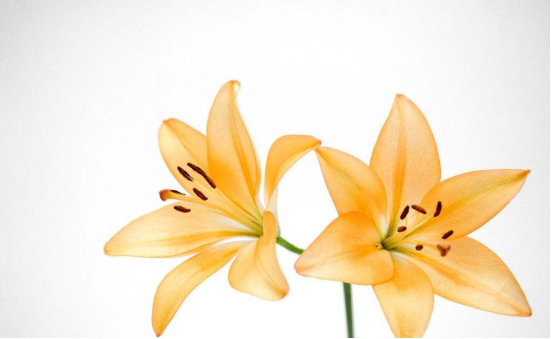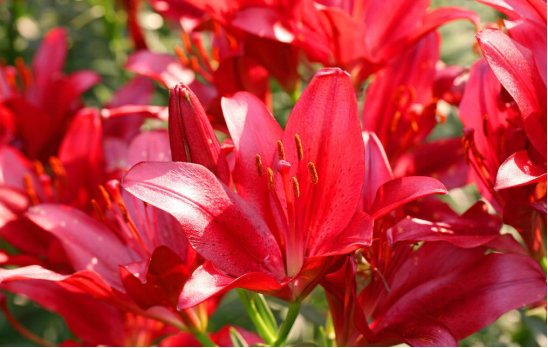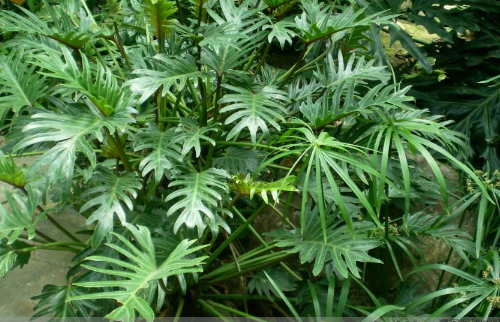The leaves of lilies turn yellow
Water yellow
This is due to the yellowing caused by watering too frequently, mainly for the yellowing of the young leaves, while there is no obvious change in the old leaves; at this time, as long as the moisture can be controlled in time.
Dry yellow
On the contrary, this is due to too little watering and lack of water, in which case the old leaves will turn yellow from the bottom up, and in serious cases, the whole plant will appear yellow leaves until death, and the right amount of water must be irrigated immediately.
Fat yellow
Similar to the principle of water yellow, it is the yellowing of leaves caused by excessive fertilizer application, which is mainly manifested by the abnormal thickening and gloss of young leaves, and the surface will be concave and convex; at this time, it is necessary to reduce fertilization or watering to dilute the concentration of fertilizer.

Hungry yellow
Contrary to Fei Huang, this is caused by too little fertilization or too low frequency, showing that young leaves and tender stems turn yellow, and if no timely measures are taken, the whole plant will eventually appear yellow leaves or even die; but excessive concentrated fertilizer can not be used at one time during treatment. Not only can not solve the problem, but also may burn roots, need to slowly, a little increase the amount of fertilizer until recovery.
Iron deficiency
In the performance of "lack of fertilizer" leaf yellow, there is also a special case of insufficient iron content, which is a reason why yellow leaves need to be paid more attention to. It is mainly shown in the young leaves, which has little effect on the old leaves, the mesophyll of the diseased leaves is yellow and the veins are grid-shaped; the solution to this phenomenon is to spray cake fertilizer, ferrous sulfate and water in the proportion of 7 to 5 to 200.
Other
In addition to the above reasons, diseases or insect pests may cause the leaves of this plant to turn yellow. If there is a disease, we can spray the corresponding antibiotics in time. If there is a pest, it is necessary to spray the corresponding agent in time.
In addition, if the soil is hardened and too hard, the root of the plant can not absorb the nutrients in the soil very well, and it is not conducive to the breathing of the root, which will also cause the leaves to turn yellow. at this time, we should loosen the soil or change the basin soil directly.
How, after reading the reasons and countermeasures for the yellowing of lily leaves introduced to you by the editor, will you never panic and get dizzy in the face of this kind of situation? Is it very helpful to you?
What about the yellowing of lily leaves? the reason for the yellowing of lily leaves
Lily, lily is a perennial herbaceous bulbous plant, what should we do when we encounter the yellowing leaves of lilies in the process of breeding? Next, let's talk about the reasons for the yellowing of lily leaves.
First, the water is yellow. Too much watering can easily cause long-term water in the basin soil, suffocating and rotting the roots, resulting in yellow leaves and even falling off; it is characterized by no obvious change in the old leaves and yellowing of the young leaves. Because the soil is too wet, the yellow leaves should stop watering, loosen the soil and let it ventilate and dry.
Second, dry and yellow. Due to lack of water and drought, it is characterized by the yellow of the old leaves from the bottom to the top. If the lack of water is a little longer, the whole plant will be yellow, or even die. It should be watered at the right time and adhere to the principle of "dry and wet, watering thoroughly".
Third, fat yellow. Caused by excessive fertilization or high concentration; characterized by thick, glossy, and uneven young leaves. Fertilizer, ploughing and watering should be controlled, and thin fertilizer should be applied once a week in summer. If you have applied too much fertilizer, you can pour more water to dilute and flush the fertilizer out of the soil.
Fourth, hungry yellow. During the growing period of potted lilies, long-term non-fertilization or insufficient fertilization will cause the phenomenon of leaf yellow. It is characterized by young leaves and tender stems first yellow. Lack of fertilizer also leads to the hardening of basin soil and the slender, yellow and tender branches. Fertilizer should be applied immediately and it will be effective within a week.
Fifth, partial fertilizer yellow leaves: lilies need more nitrogen and potassium fertilizer, and should be applied every 10-15 days during the growing period, while the supply of phosphate fertilizer should be limited, because too much phosphate fertilizer will cause the leaves to wither and yellow.
Sixth, iron deficiency yellow leaves. Lily is sensitive to soil lily salt, and the soil pH value is 5.5-6.5. The physiological diseases of iron deficiency and yellowing occurred in the alkaline conference. PH test paper can be used to monitor the pH value of fertilizer and water. Western drugstores and medical equipment are sold (2 yuan a copy, which can be used for a long time).
7. Leaf yellow during potting period: leaf yellow occurs most easily due to root injury and maladaptation to the new environment (basin soil, water quality, environmental humidity and temperature). At this time, leaf yellow should be protected, fertilized and watered dry and thoroughly, and the leaf surface should be sprayed with water. wait for the new leaves to grow and then maintain normally.
8. Diseases and insect pests: diseases and insect pests can also cause leaf yellowing. Get rid of diseases and insect pests in time.
What if the leaves of lilies turn yellow?
The lily is a kind of perennial herbaceous bulbous plant, its flower shape is beautiful and generous, the flower color is attractive, usually people like to make it into pot cultivation at home, but in the breeding process, the lily leaves often turn yellow. what should we do then? There are many reasons why the lily leaves turn yellow, and we should deal with them according to the specific situation. The following editor will tell you what to do when the lily leaves turn yellow.
What if the leaves of lilies turn yellow?
1. Overwatering makes the leaves yellow
Lilies should not be overwatered in the process of breeding, otherwise there will be stagnant water in the flowerpot, which will make its roots rot and the leaves turn yellow. at this time, we should loosen the pot soil in time, increase the permeability of the pot soil, and let it dry quickly. let the leaves continue to turn yellow.
2. Improper fertilization makes leaves yellowing.
The yellowing of lily leaves is also closely related to fertilization. if the concentration of fertilization is too high, it will make the leaves yellow. at this time, fertilizer control should be carried out in time, and intermediate ploughing and watering should be carried out. In addition, lilies can not directly apply fertilizer with too high concentration, usually should be based on the application of thin fertilizer and water.
3. The lack of certain nutrients makes the leaves yellow.
The leaves of lilies turn yellow, which may also be caused by its lack of certain nutrients. When lilies usually grow, there is a large demand for trace element iron. When the supply of this nutrient is insufficient, the leaves of hundred percent flowers will turn yellow. At this time, as long as the trace element iron is added in time, in addition, when the lilies are short of phosphorus, there will also be leaves yellowing, so usually fertilization should be more phosphate fertilizer, less nitrogen fertilizer.
- Prev

Propagation methods of lilies
Sowing and propagation collect lily seeds in advance and store them, and sow them in the next spring. About a month after sowing, lilies will sprout. They should be shaded in their seedling period, and can be planted separately in autumn. After cutting propagation, the bulbs are dug out and the scales are broken off.
- Next

Spring feather culture method
1. Soil spring feathers do not have high requirements for soil. Slightly acidic aerated and drained soil can be used. The simplest one is made of rotten leaf soil or humus soil, peat soil or garden soil mixed with river sand. It is also possible to add base fertilizer before planting, because Chunyu likes fertile soil.
Related
- Fuxing push coffee new agricultural production and marketing class: lack of small-scale processing plants
- Jujube rice field leisure farm deep ploughing Yilan for five years to create a space for organic food and play
- Nongyu Farm-A trial of organic papaya for brave women with advanced technology
- Four points for attention in the prevention and control of diseases and insect pests of edible fungi
- How to add nutrient solution to Edible Fungi
- Is there any good way to control edible fungus mites?
- Open Inoculation Technology of Edible Fungi
- Is there any clever way to use fertilizer for edible fungus in winter?
- What agents are used to kill the pathogens of edible fungi in the mushroom shed?
- Rapid drying of Edible Fungi

